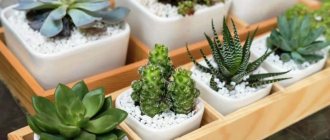A bright bouquet and indoor flowers will decorate any interior. And so that you learn to care for them not from your own mistakes, we asked florists Alena Gaidunkova, Irina Yudina And Elena Popova talk about basic recommendations for caring for flowers.
In this article we will tell you:
- How to care for indoor flowers?
- How to care for ficus?
- How to care for a cactus?
- How to care for violets?
- How to care for the flower of happiness?
- How to care for a money tree
- How to care for aloe?
- How to care for lilies?
- How to care for chrysanthemum
- How to care for gerberas
- How to care for tulips?
- How to care for cloves?
- Flower care cheat sheet
How to care for indoor flowers?
Basic care for indoor plants includes 5 steps:
- Watering. Use a watering can with a long spout. When watering, it should touch the edge of the pot. Pre-settle the water for at least 3 hours.
- Spraying. To create a warm shower, prepare a spray bottle and settled water.
- Trimming stems and removing dust from leaves. Wipe off dust from large leaves with a damp sponge, and from small and pubescent leaves with a brush. Trim stems with garden shears.
- Feeding . Choose liquid or dry fertilizers. The former are more often used for feeding indoor plants, since they provide the fastest feeding of the root system.
- Transfer. Replant a flower only if it is sick or has grown out of the pot. Plants do not like frequent replanting.
Floristry courses
online
Floristry courses
in Moscow
Floristry courses
In Petersburg
Plants in the house. TOP 7 expert tips
When creating home comfort, it is important not to disturb its melody. Living plants help the interior “sound” more alive and aesthetically. My tips will help you turn an ordinary apartment into a real fairy tale.
Turn an ordinary apartment into a real fairy tale
1 Don't overload the space. Observe the parameters of the plants and the dimensions of the room. Pay attention to the expressiveness of the shapes and color of the leaves.
2 Don't hide beauty behind curtains. Place plants in plain sight on racks and shelves, in hanging planters or on the floor.
Let everyone around you see your plants
3 Consider compatibility. Remember that tropical and exotic plants cannot form a harmonious ensemble with flowers from the last century.
Plants should be in harmony with each other
4 Focus on greenery. Containers for growing plants should not be bright or colorful. Choose neutral or plain-colored containers. It matches any interior style.
Choose neutral flower pots
5 Zone the room. Try designing ecological zones with a wall of green vines, ivy, ferns or tall plants in tubs.
Create an eco-green corner in your home
6 Look for hidden reserves. Insulate the balcony and arrange a miniature winter garden on it. Use free walls, stairs and the most secluded corners to grow indoor flowers.
Miniature winter garden on the balcony
7 Enhance the impression. If possible, place flower arrangements in front of mirrors. Play them up with soft background lighting.
Indoor plants in front of mirrors
Grow plants as simple as possible. A person does not have much time to care for flowers; it is better to choose “patient” crops. Succulents and other tropical inhabitants look good even with little care.
How to care for ficus?
Ficus is one of the plants that do not like frequent rearrangements and transplants. It is important to grow it in the same place.
In summer, the comfortable temperature for the flower is 23-25 degrees Celsius, in winter 18-20 degrees Celsius.
Rules of care:
- Water your ficus deeply and regularly as the soil dries out.
- In summer, give the flower a warm shower.
- In winter, wipe off dust from the leaves.
- Feed the plant only in spring and summer, when the flower is gaining green mass. Organic or mineral fertilizers are suitable.
Seasonal care
When entering the dormant stage, watering should be reduced.
During the period of active growth, indoor plants need regular feeding. Some require a cool winter (most bulbs) to bloom abundantly in the next season. To maintain a compact crown of trees and woody shrubs (citruses, camellias, euonymus, laurel, coffee tree), shoots are cut by one third in spring/autumn. It remains only to recall that most indoor plants come from the tropics and subtropics, where they grow in comfortable conditions all year round. In our climate, they will face severe stress in winter. This is due to short daylight hours, low temperatures on the windowsill, dry air and scorching heat from radiators. All these problems are completely solvable, you just need to want to. And we will tell you how to properly care for indoor plants in winter.
How to care for a cactus?
Cacti require a lot of sunlight. Place them on the south or east sides.
Winter is a dormant period for most cacti. Therefore, during the cold season, move it to a cool room and place it in the shade. In summer, take the plant out onto the balcony.
For watering, use water at room temperature. In summer and spring, water the cactus once every 2 days. In autumn, once every 5 days. And in winter, once every 1.5 weeks.
The warmer the room, the more often and more abundantly the cactus needs to be watered.
Preparing for winter in the fall
From September to October, the days are shorter, the weather changes, and it becomes colder. From this time on, indoor flowerpots must begin to be switched to winter mode. During the cold season, the vegetative processes of most deciduous plants slow down, and in some they stop altogether. For the winter, deciduous flowerpots are put away in a dark, cool place from the end of autumn, where they wait for spring.
To prevent flowers from experiencing stress from sudden changes in growing conditions and cold, they can be helped to “get ready to relax.” To do this, they stop feeding them, especially with nitrogen-containing fertilizers, water less frequently, moisten them and protect them from drafts.
Plants that need rest for the winter
Most bulbous and all tuberous flowers must go through winter dormancy. In autumn, their leaves naturally turn yellow and fall off or wither; you need to wait for this process and then cut the stems, leaving 2 - 3 cm.
Among the cold-loving ones, flowering ones are distinguished: tuberous begonia, fuchsia, hippeastrum, hydrangea, gloxinia, hyacinths and others.
After pruning, the plant must be treated with solutions of fungicides and insecticides to destroy and prevent diseases, fungi and pests. The roots are then stripped or left in the pot and transferred to a cool, dark place for storage. The temperature is about +5 - +10, and the roots need to be moistened periodically so that they do not dry out. Avoid overwatering, otherwise they will rot and die.
How to care for violets?
Violets should not be placed on the south side, where there is a lot of sunlight. The leaves will easily get burned and the plant will die.
The optimal temperature for a flower is 20 degrees Celsius. Violet is afraid of drafts and cold.
Rules of care:
- It is better to water the violet not from above, but through a tray, so as not to get on the rosette of the flower. The plant needs watering 1-2 times a week.
- You cannot spray violets.
- The plant should be fed only when it is in flower. Young violets need nitrogen fertilizers, and adult specimens need phosphorus-potassium fertilizers.
Air humidity
Succulents, cacti and plants with fleshy leaves do not require humid air - they know how to store moisture. Citrus trees, orchids and other inhabitants of tropical forests need moist air. Place a humidifier nearby. When growing bonsai, the Japanese place containers with miniature trees on flat trays with hydroballs. This is a great way to humidify the air. Unfortunately, we have a problem with hydroballs. If you don't have it, you can cover the tray with a layer of expanded clay or gravel and fill it with water. The plant will receive personally humidified air. Don't forget to add a new portion as it evaporates.
How to care for the flower of happiness?
Some of the most frequently purchased flowers are Spathiphyllum and Anthurium . People call them female and male happiness.
Spathiphyllum grows in nature along rivers. Create a humid and cool climate for it. The temperature should not exceed 22 degrees Celsius.
The flower does not tolerate sun or strong shade. The eastern or western side is optimal for it.
Rules of care:
- Spray 3-4 times a day.
- Water with settled, non-chlorinated water at room temperature.
- Feed with special fertilizers. In summer every 2 weeks, in winter every 3-4 weeks.
For the anthurium , choose any place; it does not have to be placed on the windowsill. He will like even the high temperature in our apartments in winter. But at the same time it is necessary to create sufficient humidity for the plant.
Rules of care:
- Spray only the leaves twice a day. No moisture should get on the inflorescence.
- Water once every 4 days exclusively with settled water.
- Once a month, fertilize the anthurium with organic, mineral or complex compounds.
Original use cases
Fashion is dictated by new trends and trends, including the cultivation of indoor plants. I would like to draw your attention to three options for using vegetation in interior design - vertical gardening, home rock garden and florarium.
Vertical gardening
Unfortunately, the parameters of many apartments do not allow for growing a large number of plants. You can add gorgeous greenery to your room without taking up much space at all. A composition of decorative foliage and flowering plants on the wall can be compared to a living painting .
“Living picture” on your wall
Vertical floral compositions are usually placed in corners and partitions, as well as free walls are dedicated to them. “Green panel” can decorate any apartment, even a small one-room apartment.
Phytowall in one-room studio
For its appearance at home, I can recommend the following plants:
- decorative varieties of red-leaved aglaonema;
- low-growing varieties of spathiphyllium,
- variegated and green-leaved fatsias;
- varieties of medium-sized and dwarf ferns;
- all varieties of chlorophytums;
- low-growing sansevieria;
- hoya;
- calathea;
- coleus (decorative speck);
- ampelous plants.
An interesting solution for any apartment
The vertical gardening method is not a cheap pleasure. In addition to financial investments, it requires regular, competent and painstaking care. I recommend it to be used only by experienced gardeners.
.
Florarium
For lovers of aesthetics, exoticism and minimalism, I can recommend growing plants in a florarium. This activity is fashionable and very exciting. It doesn’t require a lot of investment or time, and it looks visually beautiful.
Aesthetics and minimalism in one bowl
The florarium is called a mini-garden behind glass. As a basis for growing it, you can take an ordinary aquarium or other glass container. With its help, it is not difficult to give up growing exotic flowers in ordinary pots.
Mini garden behind glass
Group compositions of slow-growing plants are planted in a miniature flower garden. Among the most popular:
- ferns (polygonium, asplenium and pteris);
- sphagnum moss;
- ivy;
- small succulents;
- cacti;
- orchid;
- cyclamen;
- Saintpaulia.
Miniature slow growing indoor plants
Creating a florarium requires the right combination of plants, compliance with the general habitat and growing conditions.
Home rock garden
Not everyone can own a greenhouse or winter garden, but they still want to create a piece of living nature and come into contact with beauty. If you like this idea, then I advise you to prepare a place for a home rock garden.
Homemade flowers framed by natural stone, with the melodious murmur of water and decorative lighting - this is what you need. The rock garden will become a real highlight of the interior and your pride .
The highlight of the interior in your home
Its advantage is that the design can be adjusted by replacing or rearranging plants. There are no clear recommendations for populating a home rock garden. The main thing is to respect its geometric shapes and follow the principle from small to large .
Geometric lines when planting plants
Here I propose to show maximum imagination and improvise with tropical, exotic and the most common, decorative deciduous and flowering representatives of the flora (the only exception is cacti). A canary cage or an aquarium will help bring your paradise to life.
A home rock garden is a complex and monumental structure. It will require serious work and financial investments. However, the fantastic result of the creation justifies all the work and expense.
A lot of work in creating a masterpiece
Indoor plants give us positive emotions and help to establish inner harmony of the soul. You can talk endlessly about houseplants in the interior, no matter how amazing and beautiful they are.
TOP 5 best fertilizers for indoor plants
1BioMaster
It is produced in liquid form and has a wide range of products intended for different types of indoor plants.
2"Meister Agro"
In the form of granules it has several types, including a universal one, suitable for most types of indoor plants
3"Florist Micro"
A universal type of fertilizer, which contains the entire set of necessary chemical elements, can be used for any indoor plants
4"Tsitovit"
It is a complex microfertilizer in organic form, which contains virtually all the substances necessary for development and growth
5 "E-Alpha"
VIDEO: The most beautiful flowers for your home
Flowers at home
Updating the interior with indoor plants
How to care for a money tree
The money tree is a plant of the Crassulaceae family. Its leaves look like coins.
Caring for a money tree is easy. The main thing for him is moderate watering, periodic feeding and crown formation.
Trim mature plants to create a decorative appearance. There are several options:
- To obtain a plant with a thick stem, remove all shoots and lower leaves.
- For a classic tree, trim off any excess side branches.
- To get a lush shrub, get rid of the side leaves, but do not remove the shoots.
The trunk is always cut above the fourth pair of leaves.
Rules of care:
- Crassula does not like abundant watering. In summer, water the plant once a week, in winter once every 2 weeks.
- The flower does not require regular spraying. It is enough to wipe the leaves with a damp sponge.
- In summer, feed the plant once every 2 weeks, in other seasons once a month. Liquid fertilizers for cacti or succulents are suitable.
Plant compatibility table
| № | Conditions of detention | Plants |
| 1 | Grows slowly, likes partial shade, flowering, deciduous | Cacti, begonias, alocasia, calligraphy violets, monstera |
| 2 | Light-loving, love space | Orchid, aloe, vanda, monstera, date, abutilon, ficus, geranium |
| 3 | Diffuse color, spraying, humid air | Tradescantia, dracaena, bamboo, pilea, hedera |
| 4 | Artificial supplementary lighting in winter, abundant watering, fertilizing | Home rose, indoor jasmine, eustoma |
| 5 | Unpretentious, dry air is suitable, abundant watering without stagnation, partial shade and shadow | Eucharis, spathiphyllum, saintpaulia, stromantha, money tree |
How to care for aloe?
Aloe is a light-loving plant. Feel free to place it on a south window and do not hide it from the sun's rays.
In summer, take the plant out into the fresh air. In winter, the flower has a rest period. During this time, keep it in a cool place.
Rules of care:
- Water the plant immediately after the top layer of soil has completely dried. Avoid getting moisture into the leaf rosette, otherwise the plant may rot.
- The plant does not need to create a special microclimate. There is no need to spray it.
- Feed the flower monthly from spring to autumn. Any mineral fertilizers will do.
North window plants
A north window in an apartment with central heating is not a bad option for placing shade-loving plants. In summer it is cool, there is enough light for exotics that are afraid of direct sunlight. A sign of shade tolerance is wide leaves with a smooth surface. Begonias, guzmanias, and saintpaulias bloom brightly on a shady windowsill.
Shade-tolerant plants include leafy and flowering plants:
- dark leaf dracaena,
- aspidistra,
- maidenhair,
- eucharis,
- spathiphyllum.
In nature, these apartment dwellers developed in a warm climate under the shade of tall trees. Therefore, the absence of sunlight does not affect the decorative properties.
How to care for lilies?
Lily can stay at home for up to 2 weeks. Prepare a vase for her with settled water and add an antiseptic. An aspirin tablet, activated carbon or a few crystals of potassium permanganate will do. This will prevent the flower from rotting.
Change the water in the vase daily, rinse the stems and leaves under running water.
Remove the stamens from blooming flowers, then they will bloom much longer. A bouquet of lilies will be best preserved indoors at room temperature, away from sunlight.
Some tips from experienced flower growers
Each plant has its own care card, which describes the requirements for structure, soil fertility, and pH.
When the plant is hot, the temperature can be reduced by spraying or moistening the soil. However, water droplets in the sun turn into lenses that burn through the leaves. An electric humidifier will help - it supplies cold steam in the form of mist.
If the plant has withered, it is better to move it into the shade, shade it with a curtain, and water it lightly. In order for the bush to grow its crown evenly, it must be turned toward the light evenly.
In winter, the window sills are cold. In order for the roots to work, the planters must be placed on stands. The spring sun is aggressive. All shade-loving flowers moved towards the windows should be moved deeper into the room.
Purchased plants are kept in quarantine for 2 weeks, away from other flowers. Then the soil in the pots needs to be changed and filled with the recommended soil. Observe the plant. If necessary, feed after 1.5-2 months.
How to care for chrysanthemum
Start caring for cut chrysanthemums by cutting the stem with a knife along an oblique line. Remove the lower leaves.
Stagnation of water should not be allowed. Change it at least once every 2 days.
When changing the water, add one of these products:
- A specialized drug that is sold in florist shops. For example, "Bud".
- Aspirin. For 2 liters of water, 1 tablet is enough.
- Salt. 2 teaspoons per 2 liters of water.
- Granulated sugar. 2 tablespoons per 2 liters of water.
Chrysanthemums love cool rooms with temperatures up to 20 degrees Celsius and do not tolerate direct sunlight.
Indoor poisonous plants (photos and names)
Before you buy any indoor plant, make some inquiries - what if your plant is poisonous, and despite its external beauty, you shouldn’t bring a potential threat to all inhabitants into the house?
Dieffenbachia
The advantages of the beautiful Dieffenbachia: tall growth, spreading burdock leaves with different color options, the ability to improve the quality of the air around it... but the plant juice is poisonous! If the integrity of the plant is damaged and the poison gets on the skin or mucous membranes, then gastrointestinal and respiratory problems are possible. If juice gets on your skin, burns may occur.
ATTENTION!
Caring for Dieffenbachia is carried out only with gloves!
Dieffenbachia
Dieffenbachia often grows as a spreading bush
Euphorbia
If a curious child picks the skin of a plant and sees white juice, so similar to milk, then the following consequences are possible: diarrhea, nausea, dizziness, serious burns of the mucous membrane.
The milkweeds themselves are varied in form and, of course, beautiful. However, such beauty is not worth the risk.
Spurge
Euphorbia is very similar to a cactus with leaves.
Aloe striped, Aloe intimidating
The medicinal form of aloe looks like poisonous ones, the difference lies in the color of the plants. Striped and frightening can cause miscarriage, uterine bleeding, and serious disturbances in the functioning of the stomach.
Aloe awesome
How to care for gerberas
Cut gerberas last from 7 to 14 days with proper care.
First, distribute the bouquet. Be careful, the flowers have fragile and thin stems. Their tips should not touch the bottom of the vase.
Cut the stem along an oblique line with a sharp knife, this will increase the supply of moisture to the plant. The water in the vase should cover the stems by 4 cm. When it evaporates, it is necessary to add liquid.
Clean and trim the stems every 3 days. To do this, rinse the ends of mucus under running water.
To disinfect, add a few granules of citric acid or an activated carbon tablet to the water.
Proper watering
Houseplants should be watered with warm, settled water. Consider the volume of the flowerpot, the size and age of the plant, as well as the time of year. Over-wetting the soil is just as destructive to roots as over-dry soil. In winter, watering should be reduced - the plants rest. Don't water all the flowers on the same day - they have different needs. You can focus on the drying of the top layer of soil. But in large flowerpots, moisture can remain in the lower layer for a long time. Tap the pot with your knuckles - dry soil makes a loud sound, wet soil makes a dull sound (this method is only suitable for ceramic containers).
How to care for cloves?
For a bouquet of carnations, choose a vase with a wide neck so that the flowers are not pressed tightly against each other. The water level should be 10-15 cm.
Sweet water will help extend the life of the bouquet. Add 70 g of sugar to 1 liter of liquid and stir thoroughly.
Place the flowers in a shaded area and spray them daily.
If you want to learn not only how to properly care for flowers, but also how to create flower arrangements, sign up for a florist course. They are suitable for both those who love to create beauty at home and those who dream of mastering a sought-after profession.
To choose a teacher, look at his portfolio with ready-made compositions. The work must be done carefully and you like it.
In floristry courses you will learn:
- basics of flower arrangement;
- modern techniques for composing a bouquet;
- product packaging;
- storage of fresh flowers.
Choose courses that include the cost of flowers, packaging, frames and decorative elements to create displays. It will be cheaper than buying practice materials yourself.
At the end of the course, you will be given a certificate confirming that you are a young and promising florist.
Reviews
Natalia, 25 years old
I really love being surrounded by living plants. Renting at home is much more comfortable. But as soon as I think about the planned fertilization and replanting, panic begins. I am very glad that I can only enjoy the beauty of indoor plants, and entrust their care to professionals from. All manipulations with my green “friends” are performed simply masterfully – as quickly and efficiently as possible!
Evgeniya, 43 years old
Just recently, all the finishing work in the house was completed, and that long-awaited moment came when I was able to direct all my efforts to improving the yard. I thought that, armed with advice from the Internet, I could quickly cope with this task. It turned out that landscaping requires deep knowledge and specialized equipment. I didn’t dare to ruin my dream of an ideal courtyard, so I started creating it. Thank you very much for the work done!
Tatyana, 58 years old
I have a fairly large house and every room is surrounded by decorative flowers. Every year it becomes more and more difficult to care for them, especially since my collection is constantly replenished with new specimens. So that many years of efforts would not be in vain, I decided to ask for help. A friend recommended visiting the website serissa.ru. I was pleasantly surprised by the variety of the company's services and its affordable prices. Now I don't have to worry about my flowers losing their attractiveness.
You can find a complete list of reviews in the reviews section.
Flower care cheat sheet
The main thing is to provide the flowers with the proper microclimate.
Find out the most complete information about your plant:
- where to put it;
- how often to water and spray;
- when and what to feed.
Cut plants will last longer if they change the water daily, trim the stems and feed them with a mixture for bouquets, which are sold in every flower shop.
Follow the rules of care, and then the flowers will delight you for many years.
Do your indoor flowers survive? What products do you use to extend the life of your bouquet? Write in the comments about your knowledge and experience. Repost so you don’t lose the article and read it over the weekend.
This training may be right for you:
- 10 Best Online Floristry Training Courses
- Best Floristry Courses in Moscow from 1,300 Rubles
- Best Floristry Courses in St. Petersburg
Unpretentious indoor plants, their photos and names
Kohleria (lat. isoloma (kohleria))
A plant that blooms all year round with velvety tubular red or orange flowers is considered one of the most low-maintenance plants. Green, slightly pubescent, with fine teeth, the leaves perfectly set off the beautiful flowers.
Kohlerias love light partial shade and watering during the growing season and flowering once every 3 days.
The plant grows 60 cm and lives up to 3 years.
IMPORTANT
Leaves do not tolerate water.
Tradescantia
The undeservedly forgotten American plant has dozens of varieties and a common structure for all types: Long straight shoots with numerous branches represent a rather massive bush. Green, silver, purple with veins, striped Tradescantia blooms with small flowers also of different colors.
With moderate regular watering and placement in diffused sunlight, such a plant can delight for many years. Pruning only improves the appearance of Tradescantia.
Spathiphyllum Wallis (lat. spathiphyllum wallisii)
This plant with its 30-50 cm leaves on long petioles is very similar to a lush bush. The decorative qualities of spathiphyllum are beyond praise. White flowers with soft yellow, beige or white-green spadix appear throughout the year.
Spathiphyllum Wallis looks great when there is a lot of it
Spathiphyllum Wallis Spathiphyllum grows in bright, diffused light and regular watering. It is best if the substrate is always moist and without stagnant water. With feeding and proper care, the plant lives for 10 years.
Tips for a florist: how to care for the “Women’s Happiness” flower or spathiphyllum In a special publication on our portal, we will tell you in detail about the flower, which is called “Women’s Happiness,” how to properly grow, propagate, feed and pruning, and what problems you may encounter.











